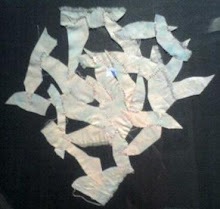by: Wislawa Szymborska
This poem is important to me, because it was the the first poem that we discussed in my English class during my sophomore year of high school. This poem and the power of the words converted me from the "majority" of which Szymborska speaks, to the "Some" that actually "like" "poetry."
Each stanza delves into the meaning of each of the words "some", "like", and "poetry." I wanted to continue the trend of breaking down words. Szymborska does an excellent job of discussing what the words are supposed to symbolize, but I wanted to visually break down the words-- the letters that symbolize sounds that form words that provide cultural expectations of carrying a meaning. I did this in a few ways.
For starters, I knew I wanted to create 3 separate books for each stanza. It was important to me to allow for the words/stanzas to be isolated when the books are being read. This reinforces the concept of close examination. These books were constructed by removing the pages from a store-bought photo album and hand-sewing them together to bind them.
The initial background image of each page is actually an individual letter from the words "some" "like" and "poem" in a font that is actually a series of symbols. This background image is unable to be recognized as any particular letter and is brought even further through warping the vectors to abstract the abstraction.
Which each page, the words are strategically placed and modified to form the letter on the page, for example the page with the warped image of "L" would have the text on the page form the recognizable letter "L". I found this to be an interesting study on the arbitrary selection of the symbols that are letters, and thus, connote how the purpose of words to provide meaning is paralleled by the purpose of letters to form words. It is the words that form the letters. The scrutinizing viewer is only rewarded to an extent, for only so much is able to be discovered to fully understand the meaning of the books. This parallels the conclusion that Szymborska draws in the poem's conclusion-- Some things are abstract and can not be pinned down to show their origin, but instead their meaning and value is relative to who is seeking understanding and what they gather on their own.

All of the images were created within Illustrator and printed in CYMK on the Phaser printer.
Text used:
Caravan (abstract/warped text)
Briem Script (lines of the poem)






.jpg)




